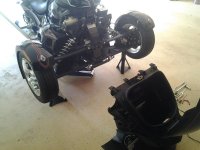On the eve of picking up our 2013 ST-S I have a hypothesis as to what might be causing some 2013 owners to have excessive heat and some not. The "NEW airflow side panel design" puts a triangular shaped vent on either side of the body that looks like it will direct air into the center section area around the engine where all this heat is building up. Take a look at any of the 2014 pics like this one...
http://www.spyderlovers.com/forums/album.php?albumid=3070&attachmentid=75801
Now when a 2013 model is NOT equipped with fog lights those two black scoops on the front adjacent to the frunk look like they are open and also vent air to the center section around the engine. Could those that are experiencing excessive heat be equipped with fog lights which blocks the air flow?
http://www.spyderlovers.com/forums/album.php?albumid=3070&attachmentid=75801
Now when a 2013 model is NOT equipped with fog lights those two black scoops on the front adjacent to the frunk look like they are open and also vent air to the center section around the engine. Could those that are experiencing excessive heat be equipped with fog lights which blocks the air flow?

